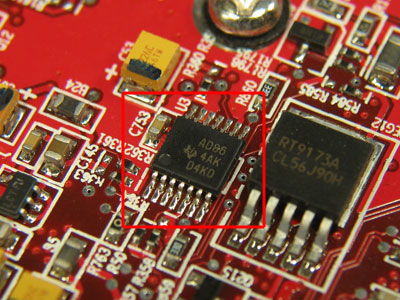Guide to Video BIOS flashing |
|
Introduction

The video is BIOS is a small piece of code (typically <64 KB), which is stored inside a small chip on your video card. When the VGA card receives power, the BIOS is loaded into system memory and immediately executed by the CPU.
On startup, the BIOS initializes the video card:
- Initialize the GPU
- Detect number of memory chips, chip size, access mode
- Enable memory access and set proper timings
- Detect if external devices (analog VGA, DVI, TV-out) are connected and enable them
- Set core and memory clock
- Enable power management
- Set fan speed (if supported by the board)
Once you boot into Windows, the display driver takes over all video functions and the BIOS is no longer used. However, it remains accessible for execution. Actually, manufacturers like ATI added a handful of functions which can be invoked from within Windows, for example to change power management settings on a mobile GPU.
Why flash the BIOS?
Originally, the video BIOS was stored in a ROM (Read Only Memory) and could not be replaced. Nowadays it is located in a flash memory chip (that's why it's called 'flashing').The reason for this move was that like every other piece of software, the BIOS had programming errors, or an issue was detected in the hardware for which a workaround had to be found. So the manufacturers just gave out an updated BIOS to a customer to fix the issue.
The more interesting use is to mod cards. For example, on the X800 Pro VIVO you can unlock additional pipelines by changing the BIOS. How so? Inside the BIOS is a small block of information which tells the GPU how many pipelines it should run at. If you replace the original BIOS with a BIOS which tells the GPU "16 Pipelines!" .. well, then you are running 16 pipelines.
Another good use is to change the default clocks of the card. As you remember from above, the BIOS sets the core and memory clock. On the last page of this article we will cover the different BIOS editors and their use.
Sometimes a new BIOS increases performance as well. However, my personal experience is that this difference is rather small. However, if you do upgrade your video BIOS for this reason, make sure you run benchmarks before and after.
Mar 13th, 2025 11:31 EDT
change timezone
Latest GPU Drivers
New Forum Posts
- And so... I bought Arrow Lake (13700k to 265k), my thoughts. (18)
- Free Games Thread (4554)
- The TPU UK Clubhouse (25886)
- What's your latest tech purchase? (23294)
- What motherboard with spdif should I get? PC to 5.1 blu-ray player via optical (15)
- I'm looking for a good tool to make the 3D scanning of my mini-pc using the photogrammetry and my Kinect 2. (96)
- Cant Enable Resizable Bar (12)
- Gsync work on lg c3 connected to a display port of 4080s? (0)
- 22" same price, brand, but not type, compare (2)
- Nvidia's GPU market share hits 90% in Q4 2024 (gets closer to full monopoly) (903)
Popular Reviews
- AMD Ryzen 9 9950X3D Review - Great for Gaming and Productivity
- Sapphire Radeon RX 9070 XT Nitro+ Review - Beating NVIDIA
- XFX Radeon RX 9070 XT Mercury OC Magnetic Air Review
- FSP MP7 Black Review
- Dough Spectrum Black 32 Review
- ASUS Radeon RX 9070 TUF OC Review
- ASUS GeForce RTX 5090 TUF Review
- AMD Ryzen 7 9800X3D Review - The Best Gaming Processor
- NVIDIA GeForce RTX 5070 Founders Edition Review
- MSI MAG B850 Tomahawk Max Wi-Fi Review
Controversial News Posts
- NVIDIA GeForce RTX 50 Cards Spotted with Missing ROPs, NVIDIA Confirms the Issue, Multiple Vendors Affected (513)
- AMD Radeon RX 9070 and 9070 XT Listed On Amazon - One Buyer Snags a Unit (261)
- AMD RDNA 4 and Radeon RX 9070 Series Unveiled: $549 & $599 (260)
- AMD Mentions Sub-$700 Pricing for Radeon RX 9070 GPU Series, Looks Like NV Minus $50 Again (249)
- NVIDIA Investigates GeForce RTX 50 Series "Blackwell" Black Screen and BSOD Issues (244)
- AMD Radeon RX 9070 and 9070 XT Official Performance Metrics Leaked, +42% 4K Performance Over Radeon RX 7900 GRE (195)
- AMD Radeon RX 9070-series Pricing Leaks Courtesy of MicroCenter (158)
- AMD Radeon RX 9070 XT Reportedly Outperforms RTX 5080 Through Undervolting (103)